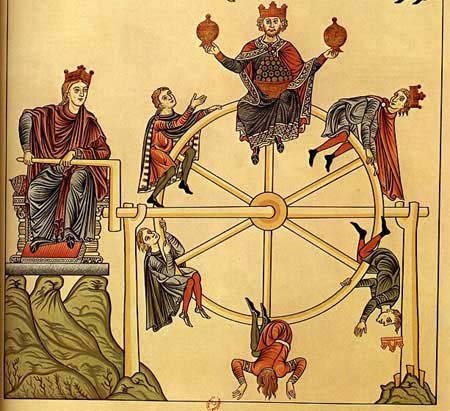In his Mythgard Academy class,  Corey Olsen pointed out that The Consolation of Philosophy contains a reference to how small the Earth is compared to the cosmos. This comes from Ptolemy in the 2nd Century CE, and is qualitatively correct.[1] By that point in the text, I had noticed that Boëthius argues frequently from scientific evidence, and I’d been highlighting the various claims he makes. Suppose he were being graded by a modern science teacher – here’s how he might come out.
Corey Olsen pointed out that The Consolation of Philosophy contains a reference to how small the Earth is compared to the cosmos. This comes from Ptolemy in the 2nd Century CE, and is qualitatively correct.[1] By that point in the text, I had noticed that Boëthius argues frequently from scientific evidence, and I’d been highlighting the various claims he makes. Suppose he were being graded by a modern science teacher – here’s how he might come out.
Physics
“Sound fills the ears of many at the same time without being broken into parts.” This sentence was the thing that set me to high-lighting. I had no idea that they knew that much wave theory in Late Antiquity. Nowadays, we call this Huygens’ Principle. Huygens gets the credit, not Boëthius, because his formulation allows it to be used for experiments and theoretical advancements. 10/10.
Mathematics
“Then, for the same reasons, this also is necessary—that independence, power, renown, reverence, and sweetness of delight, are different only in name, but in substance differ no wise one from the other.” (Bk. 3, P10.) “Either there is no single end to which all things are relative, or else the end to which all things universally hasten must be the highest good of all”. (Bk. 3, P11)
These two are pretty much the same claim, that all good things are unified. Boëthius wants to define a highest good, so he needs good things to be a well-ordered set, or different people might have different ideas about what constitutes the “highest”. This proposition is essential to his entire argument, and it’s a theorem of mathematics: you can’t have a well-ordered set made of multiplets of numbers. Whether this is logically equivalent to monotheism, I leave to theologians, who by both nature and training are more subtle than Idiosophers. 10/10.
Economics
“nothing can be better in nature than the source from which it has come;” (Bk. 3, P 10.)
Incorrect. The whole purpose of human labor is to add value to raw materials. The Winged Victory of Samothrace is much “better in nature” than a block of marble in a quarry. 0/10.
“How poor and cramped a thing, then, is riches, which more than one cannot possess as an unbroken whole, which falls not to any one man’s lot without the impoverishment of everyone else!”
Boëthius does not know about economies of scale. Division of labor and cooperation via markets have brought prosperity to our world that would be unimaginable in his. While it is true that the principle is frequently abused and greedy rich men enjoy impoverishing those around them, nevertheless the foundation of the global capitalist economy encourages entrepreneurs to find ways to produce goods en masse, which thereafter make entrepreneurs fabulously wealthy while improving the lot of their customers. Boëthius sees only the down side and misses the positive. 5/10.
Biology
“[If satisfying bodily desires] can make happiness, there is no reason why the beasts also should not be happy, since all their efforts are eagerly set upon satisfying the bodily wants.”
Your Idiosopher infers that Boëthius did not have pet dogs. I have fed Labrador Retrievers — if there is any creature on Earth that has ever attained a more perfect happiness than those dogs at dinner time, I have not seen it. 3/10; maybe he had a cat.
“[W]ould not that body of Alcibiades, so gloriously fair in outward seeming, appear altogether loathsome when all its inward parts lay open to the view?” (Bk. 3, P8)
Never having met Alcibiades, your Idiosopher can not talk about the condition of his specific innards. But inward parts in general can be fascinating. The human brain is a supercomputer that runs on 50 W of power and fits in a hat.[2] Kidneys are marvelously effective filtration systems for their size. And if you gave me a handful of jelly and told me to build two cameras out of it, I feel sure that the result would be much less effective than eyes. This is an attitude that derives from disgust, not science. 0/10.
“Nature is content with few things, and with a very little of these. If thou art minded to force superfluities upon her when she is satisfied, that which thou addest will prove either unpleasant or harmful.” (Bk. 2, P 5.)
Anyone who has ever kept a vegetable garden knows this is not the case. Nature is all about superfluity. Bacteria, plants, fungi, and animals all reproduce to the maximum extent that resources will allow, because that’s the best way to guarantee survival when they are surrounded by predators. The story of nature is the contest for resources among a multitude of over-procreative species. Vegetable gardens produce food because gardeners intervene in the process, warding off predations so the surplus production of the plants is not consumed by competitors, but rather by the gardeners themselves. As James Lawson describes it in his First Steps to Botany (1826): “No species, perhaps, either of plant or animal is made for itself alone ; and hence, as vegetables produce a superabundance of seeds for the nourishment of certain races of animals….” 0/10.
“Looking to living creatures, which have some faults of choice, I find none that, without external compulsion, forego the will to live, and of their own accord hasten to destruction. For every creature diligently pursues the end of self-preservation.” (Bk.3, P11)
There are many creatures that devote themselves to a higher end than their self-preservation. Bees will unthinkingly sting anyone who threatens their hive, though they die in the process. Ants will drown so their hill-mates can cross a stream. Human soldiers give their lives for their countries. 0/10.
“‘Now, dost thou know,’ said she, ‘that all which is abides and subsists so long as it continues one, but so soon as it ceases to be one it perishes and falls to pieces?” (Bk.3, P11)
“Now, that which seeks to subsist and continue desires to be one; for if its oneness be gone, its very existence cannot continue.” (ibid.)
This is incorrect. Bacteria, amoebae, and many other micro-organisms die unless they split themselves into parts. Mitosis in the higher animals works the same way. I wonder how Boëthius would have reacted, had he known that for most living creatures, remaining unified means extinction. It seems to tie into the monotheistic foundation of his philosophy, but in a contrary sense. 0/10.
Conclusion
Our good Anicius Manlius recapitulates the phylogeny of science fairly well. The older the science, the better he understands it. He’s an “A” student in math and physics, but the newer sciences contradict his evidence at every turn.
[1] Richard Fitzgerald, in the physics department at UT-Austin, has translated the Almagest of Ptolemy, not only into English, but into modern mathematical notation as well. I love the Internet.
[2] Your move, Apple!





